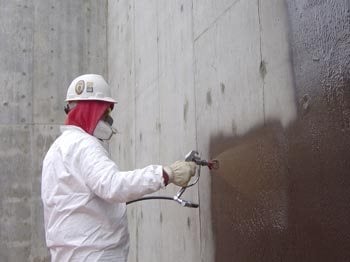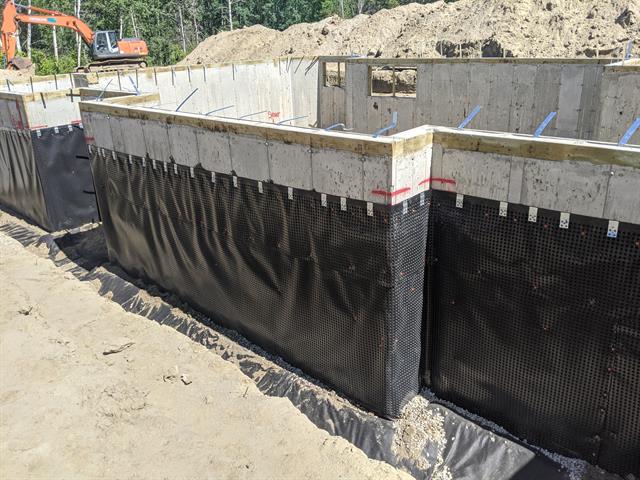Exploring the Various Techniques and Solutions for Effective Damp Proofing
Dampness in buildings presents substantial challenges to both structural stability and indoor air quality. Different strategies and services have emerged to battle this pervasive issue. From typical damp-proof membranes to ingenious chemical treatments, each technique provides one-of-a-kind benefits. Comprehending these alternatives is vital for reliable wetness control. Nevertheless, picking the best remedy depends on particular structure conditions and requirements, triggering further exploration into one of the most reliable wet proofing approaches readily available.
Recognizing the Reasons of Moisture
Although dampness can develop from various sources, recognizing these reasons is crucial for efficient remediation. Frequently, dampness stems from 3 primary sources: climbing wet, permeating moist, and condensation. Rising wet happens when groundwater travels up-wards through porous materials, such as block or rock, usually as a result of an absence of an effective barrier (damp specialist newcastle). Penetrating damp is typically brought on by outside variables, consisting of roofing leakages, damaged rain gutters, or harmed walls, allowing water to penetrate a building. Condensation, on the other hand, arises from excess wetness airborne, commonly exacerbated by inadequate ventilation and temperature differences, leading to water droplets forming on surface areas. Determining these underlying issues is vital, as each kind of moisture calls for a customized strategy for remediation. Proper evaluation aids in identifying one of the most efficient solutions, eventually protecting the architectural honesty of a structure and enhancing indoor air high quality
Standard Damp-Proof Membranes

Chemical Damp-Proofing Solutions
Chemical damp-proofing services use a cutting-edge method to stop dampness invasion in structures. These techniques normally include the application of liquid chemicals that penetrate stonework and develop a barrier against climbing moist. Commonly made use of chemicals include silanes, siloxanes, and various other water-repellent representatives that react with surface area materials to create a hydrophobic layer.The application procedure typically needs boring openings into the wall surfaces, infusing the chemical remedy, and allowing it to treat. This method is especially advantageous for older structures where standard damp-proof membrane layers might be unwise. Additionally, chemical damp-proofing can be much less disruptive and extra affordable than extensive restoration projects.While reliable, these options depend on appropriate application and environmental conditions for peak efficiency. Normal maintenance and monitoring are important to ensure the longevity of the damp-proofing therapy. In general, chemical damp-proofing represents a functional option for guarding buildings versus moisture-related damage
Dental Caries Wall Building And Construction Strategies
Dental caries wall surface building methods provide various benefits, particularly in moisture control and power performance. By including an air space in between two layers of stonework, these walls properly mitigate water access while boosting insulation. This combination not only secures frameworks from wetness but likewise adds to lowered power consumption.
Benefits of Tooth Cavity Wall Surfaces
When considering efficient damp proofing methods, the advantages of tooth cavity wall surfaces stand out prominently. Cavity walls contain two separate layers, producing an air space that properly decreases dampness penetration. This design minimizes the danger of dampness, as the external wall serves as an obstacle against rain and water ingress. Additionally, tooth cavity wall surfaces boost thermal insulation, which adds to power performance by lowering warmth loss. They additionally give audio insulation, assisting to create a quieter interior atmosphere. Furthermore, the air gap allows for air flow, which assists in dampness control and lowers the possibility of mold development. These advantages not only enhance the overall convenience of a structure however also add to its long life and structural integrity.
Dampness Control Approaches
Reliable wetness control techniques are crucial in dental caries wall building and construction to ensure long-term defense against moisture. One primary technique involves the consolidation of weep holes, which assist in water drain from the cavity, stopping accumulation. In addition, the use of breathable membrane layers can aid handle dampness levels while enabling entraped vapor to leave. Correct positioning of insulation is likewise essential, as it must not block water drainage courses. Additionally, ensuring that the outer leaves of the dental caries wall surface are constructed with water-resistant materials improves total sturdiness. Regular maintenance checks are necessary to recognize any kind of clogs or damages early, guarding the framework's integrity. Ultimately, a combination of these methods develops a robust defense against moisture intrusion in cavity walls.
Insulation and Power Efficiency
Insulation plays a vital role in boosting power efficiency within dental caries wall building. By including shielding materials, these walls produce a thermal barrier that lessens heat loss and decreases energy consumption. Effective insulation not just helps keep a stable interior temperature yet likewise alleviates the danger of dampness, as it prevents condensation within the wall surface cavity. Various strategies, such as using inflexible foam boards or mineral woollen, can be employed to attain suitable insulation performance. Furthermore, correct installment is necessary to assure that spaces and spaces are lessened, which can or else compromise energy efficiency. Inevitably, a well-insulated cavity wall surface contributes greatly to general sustainability and lowers heating & cooling prices for property owners.
Exterior Damp Proofing Techniques
External moist proofing methods are necessary for securing structures from dampness infiltration. 2 efficient strategies include the application of water-proof membranes and the installation of French drains pipes. These solutions aid reduce water buildup and protect the honesty of buildings.
Waterproof Membrane Layer Application
While various techniques exist for avoiding dampness ingress, the application of water resistant membrane layers stays an extremely reliable external wet proofing strategy. These membrane layers are commonly made from products such as polyethylene, rubber, or customized asphalt, offering a robust obstacle versus water penetration. The setup process includes using the membrane layer to the exterior surfaces of wall surfaces or structures, making certain complete insurance coverage to avoid leaks. Appropriate attachment and securing at joints are critical to optimizing effectiveness. Waterproof membranes can be applied in different types, consisting of fluid layers and sheet membranes, allowing for versatility based on the particular demands of the framework. This technique not only safeguards buildings from dampness but also boosts their longevity and architectural honesty.
French Drainpipe Setup
One efficient approach for managing groundwater and avoiding moisture build-up around a building's foundation is the installation of a French drain. This drain system contains a trench full of crushed rock and a perforated pipeline that reroutes surface water away from the structure. Correct setup requires mindful preparation, making sure that the drain slopes away from the structure to assist in ideal water flow. In addition, the area of the drain is vital; it ought to be positioned in locations prone to pooling or excess dampness. Routine upkeep, including clearing up particles from the gravel and making certain the pipeline stays unblocked, is vital for long-term performance. Eventually, a well-installed French drain can significantly minimize the danger of water-related concerns in cellars and structures.
Interior Waterproofing Approaches
Interior waterproofing approaches are important for shielding a building's interior from moisture infiltration and prospective water damage. These methods typically entail the application of specialized products and techniques made to produce a moisture obstacle within the framework. One typical strategy is the usage of waterproof finishes or sealants on wall surfaces and floorings, which avoid dampness from permeating surfaces.Additionally, mounting interior drain systems, such as sump pumps, can properly handle water buildup in basements and crawl rooms. Another approach entails the use of vapor obstacles, which are set up to inhibit moisture activity from the ground right into living spaces.Moreover, dealing with any cracks or spaces in walls or structures with proper sealers assures a comprehensive defense against water invasion. By carrying out these indoor waterproofing approaches, homeowner can substantially minimize the danger of mold and mildew growth, architectural damages, and other moisture-related problems. Appropriate execution of these techniques is vital for long-lasting security and building stability.
Routine Upkeep and Examination Practices
Normal upkeep and assessment techniques are crucial for ensuring the long-lasting efficiency of wet proofing options in any type of structure. Routine checks enable home owners to identify very early indications of wetness intrusion, such as peeling paint, mold and mildew development, and mildewy odors. These indicators can signal underlying concerns that need immediate attention.Inspections should be performed at the very least yearly, focusing on at risk locations like cellars, creep areas, and exterior wall surfaces. During these assessments, homeowner must examine sealers, drain systems, and ventilation to verify they function correctly.Additionally, preserving gutters and downspouts is crucial, as clogged systems can result in water accumulation near the structure. Executing a routine maintenance timetable, along with timely fixings, can substantially expand the lifespan of damp proofing actions and safeguard the structural integrity of the structure. Positive steps inevitably add to the total health and wellness of the living setting.
Regularly Asked Concerns
The Length Of Time Does Damp Proofing Normally Last?
The duration of moist proofing efficiency differs, generally lasting in between 20 get more info to half a century. Factors such as application high quality, environmental conditions, and upkeep practices substantially affect the long life of the damp proofing therapy.

Can I Damp Proof My Home Myself?
The specific pondered the usefulness of do it yourself damp proofing. With appropriate research study and the right materials, it is feasible. Nonetheless, they additionally identified the value of expert assistance to guarantee durable performance and stop future concerns.
What Are the Indicators of Inefficient Damp Proofing?
Indicators of ineffective moist proofing consist of persistent mildewy odors, noticeable mold development, peeling paint, moist spots on walls, and wood degeneration - damp proofing newcastle. Home owners ought to resolve these issues promptly to avoid further damage and wellness issues
Does Damp Proofing Affect Indoor Air High Quality?

Just How Much Does Specialist Damp Proofing Cost?
Expert wet proofing costs vary substantially, usually varying from $1,000 to $5,000 depending on the property's size, the degree of the wet issue, and selected approaches. Each situation needs a customized analysis for accurate prices. Frequently, wetness originates from 3 key resources: rising moist, passing through wet, and condensation. When considering reliable damp proofing techniques, the advantages of dental caries wall surfaces stand out plainly. External moist proofing techniques are essential for safeguarding frameworks from wetness infiltration. While numerous methods exist for preventing wetness ingress, the application of water-proof membranes continues to be an extremely effective outside moist proofing strategy. Indicators of ineffective damp proofing consist of consistent stuffy smells, noticeable mold development, peeling off paint, damp patches on wall surfaces, and wood decay.
Comments on “Seven key techniques for mould removal newcastle that deliver results”